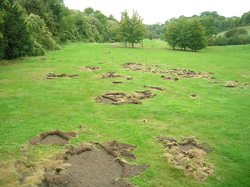Adult males are drawn into the chafer beetle trap by means of a pheromone attractant lure. Once the Garden Chafer beetles fly to the trap, they hit the plastic vanes on top, and are funnelled down inside, where they are unable to escape.
The chafer beetle trap catches the most common species of chafer beetle, the Garden Chafer Phyllopertha horticola. The chafer beetle trap alerts greenkeepers and turf mangers that Garden Chafer beetles are present and that egg laying will follow. Once the adult female has laid its eggs, they will develop into chafer grubs, leading to both primary and secondary damage of turf surfaces such as; golf greens, tees, fairways and semi roughs, cricket outfields, bowling greens, sports pitches and ornamental lawns.

- Primary Damage: Chafer grubs feed on grass roots reducing the plants ability to source water and food leading to greater susceptibility to biotic (organism) and abiotic (environmental) stress. The impeded rooting depth also reduces the surface stability of turf areas.
- Secondary Damage: Birds and mammals are attracted to the beetle larvae as a food source where they can cause extremely severe damage to turf surfaces as they peck and dig for the grubs.
Chafer Beetle traps help to reduce adult beetle egg laying and give a valuable warning that chafers are present. Monitoring the active life stage of insect pests forms an integral part of Integrated Pest Management and allows for better informed application timing of Entomopathogenic Nematode treatments.
Technical Information
The chafer trap can be re-used each year when a new lure capsule is added.
The trap should be placed in lawn areas and hung 50-100 cm above ground level.
Area coverage: One trap will cover up to 2000 sq metres or half an acre.
The trap is supplied with an attractant lure that will last up to six weeks, which covers the main flying season of the chafer beetle.
Chafer traps should be positioned outdoors by May and remain in place throughout June.
For more in depth information, please read the Integrated Management Strategies For Maximising The Efficacy Of Entomopathogenic Nematodes document.
Instructions for Use

Construction Instructions
- Interlock the vanes (A into B) and insert the four plastic pins in to the corresponding holes on the funnel.
- Push the lid firmly into position on to the vanes.
- Fix the funnel to the bucket with a twist action lining up the slots.
- Feed the string through the holes in the lid.
Suspend the chafer trap with the string at a height of 50-100 cm from the ground.
How to Insert the Attractant Lure
- Remove the attractant from the aluminium sachet (plastic vial containing liquid attractant).
- Cut the top of the vial off with scissors, then keeping upright, place in the cage and seal with the cap.
- Insert the cage into the hole at the top of the lid and push down making sure the case is secure.
Pheromone Attractant Storage Instructions
The aluminium sachet containing the lure should be stored in a freezer or fridge until use. If stored in a freezer at -18 °C the lures will have a shelf life of 2 years from the date of production.
Safety Information
We recommend you wear gloves when handling the lure.
The attractant will remain active for 6 weeks.
Keep the attractant lure out of the reach of children.
Chafer Beetle Trap Components
Natural Bucket, Green Funnel, Green Vanes, Green Lid, String, Cap, Cage and Attractant Lure.
To discuss further information regarding the Chafer Beetle Trap and Replacement Lures, or to place an order via phone call, please contact our technical sales team on 01902 440250.
